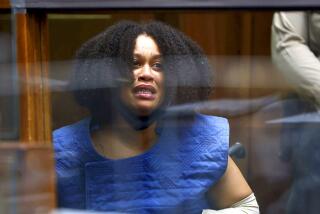‘I Cried and Said, That’s Not Me’
- Share via
Jung Won Ko was hospitalized for two months, much of it in an anesthetic haze, after she was hit by a car being pursued at high speeds by police.
It took four weeks for her friends to tell her what had happened to her face. Nobody had the courage. Once they did, it took all her strength to look in a mirror.
“I just cried and said, over and over, that’s not me, that’s not me!” she said.
In the year and a half that followed, the 25-year-old South Korean, in the United States on a student visa, has endured a stream of misfortunes:
Unable to attend school, she spent months fearing that the Immigration and Naturalization Service would revoke her immigration status and send her back to South Korea, where she says she would be scorned for her facial scars.
Unable to afford to travel, she couldn’t return to Seoul when her father died of a stroke.
Unable to work and facing more than $350,000 in medical bills, she ended up broke, relying on donations from sympathetic Korean businesspeople in Los Angeles to pay her rent and food.
Of the few friends she had here, some--including her boyfriend--abandoned her, she said.
Finally, after unsuccessfully attempting to collect damages from the uninsured driver who hit her, Ko sued the police departments involved in the chase. She claimed that officers used poor judgment when they became involved in a freeway chase of a man they originally wanted to stop merely on suspicion of running a stop sign on a surface street.
A Superior Court judge dismissed her case, but her attorneys plan an appeal.
“She’s in this country very much by herself, without a lot of support . . . but through all of this Jung Won has shown amazing courage,” said Dr. Charles Spenler, the USC burn specialist who has treated her injuries since shortly after the accident.
On April 14, 1997, Ko was driving to Torrance on the Artesia Freeway to visit her sister. Unknowingly, she was traveling just ahead of a police chase that had started in South-Central Los Angeles when David Contreras, allegedly driving drunk in a sport utility vehicle, ignored a stop sign.
Pursued onto the freeway by two LAPD patrol cars and eventually by Los Angeles County Sheriff’s Department units, Contreras ended up hammering Ko’s Jetta from behind.
The Jetta careened into a steel guardrail and exploded in a fireball. Ko, enveloped in flames, was pried from the wreckage, barely alive. Second- and third-degree burns laced much of her body.
Months later, when she looked in a mirror that first time, Ko saw an unrecognizable woman.
The right side of her face was untouched, her smooth brown skin and delicate features intact. But the accident turned the left side and much of her upper body into a patchwork of off-color, uneven skin grafts and disfigured flesh.
After realizing the full extent of her injuries, Ko spiraled into a deep depression.
“I almost never showed myself,” she said. “To me, much of the time since the accident is just a blur.”
She did little else but sleep, cry and spend countless hours alone in a tiny Koreatown apartment.
Afraid of what others would think when they saw her, Ko said it wasn’t until the last month that she was able to go outside without worry.
Ko is just one of thousands of people injured or killed by police pursuits nationwide each year. Many of them are innocent victims. And California, according to statistics gathered by the National Highway Traffic Safety Board, has by far the worst record of deaths and injuries from police-involved chases.
In an eight-year period ending in 1997, an average of 56 people died annually in California as a result of police chases. About one-quarter of the victims were bystanders.
Although no official records are kept on injuries alone, victims-rights groups estimate that the number of innocent people suffering injuries from police chases ranges from 200 to 400 in California each year.
The legal system has not proven kind to those victims.
California statutes hold that as long as police departments have basic written policies regarding pursuits, as the LAPD and L.A. County Sheriff’s Department do, those agencies and their officers have immunity from prosecution. Further, the Supreme Court ruled last May that departments could not be held liable for injuries caused by chases unless it could be shown they acted with “intent to harm,” a standard most legal observers agree is almost impossible to overcome.
The Asian Pacific Legal Center, which is assisting Ko, has asked U.S. Sen. Barbara Boxer (D-Calif.) to intervene. It wants Boxer to push the INS to consider granting Ko permanent citizenship so she can remain in the United States to take advantage of better medical care for burn victims.
Meanwhile, Ko, who has had six operations and is scheduled to have at least five more in the near future, says she is finally coming to terms with the permanence of her injuries. “I guess people will have to know me for something different than what is outside.
“People have to learn to see what is in here,” she said, pointing to her heart. “And I will have to remind myself to feel that way too.”










